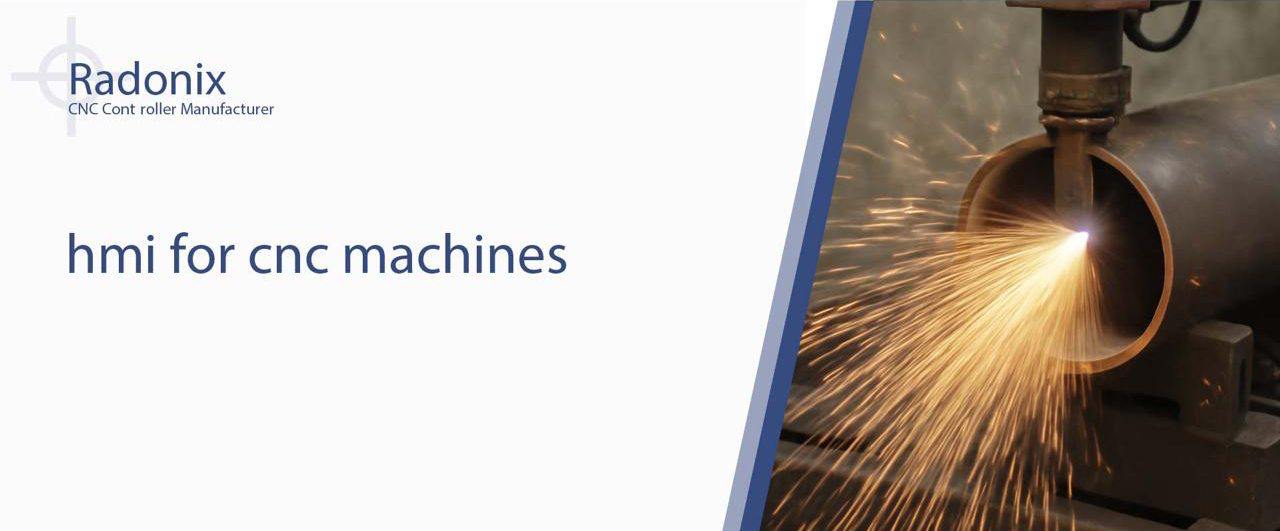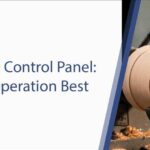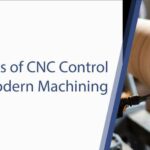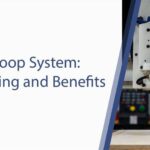In the world of manufacturing, precision is paramount. Every cut, every weld, and every movement of a machine must be executed with flawless accuracy. At the heart of this precision lies the Human-Machine Interface (HMI).
Specifically, the HMI for CNC machines is not just a screen—it’s the critical link between the operator and the complex, high-speed machinery. It’s the difference between a successful production run and a costly error.
For decades, Computer Numerical Control (CNC) machines have revolutionized manufacturing, offering unparalleled automation and repeatability. However, the true potential of these machines is unlocked by a well-designed and intuitive HMI for CNC machines.
This interface empowers operators, simplifies complex tasks, and provides real-time insights, leading to increased productivity, improved safety, and higher-quality products.
What Is an HMI for CNC Machines?
An HMI for CNC machines is a user interface or dashboard that allows an operator to monitor, control, and interact with the CNC machine. Think of it as the machine’s “face” or “brain” that you can directly communicate with.
It replaces traditional knobs, buttons, and switches with a digital interface, often a touchscreen, which displays critical information in a clear and organized manner.
These interfaces aren’t just for turning the machine on and off. A modern HMI for CNC machines provides a wide array of functions, including:
- Program Loading and Editing: Operators can easily load G-code and M-code programs, and even make quick edits on the fly.
- Real-time Monitoring: The HMI displays critical data such as spindle speed, feed rate, tool position, and machine status.
- Alarms and Diagnostics: It provides instant alerts for errors, maintenance needs, or safety issues, allowing for quick troubleshooting.
- Tool Management: Operators can manage tool libraries, track tool wear, and set up new tools directly from the interface.
- Simulation: Many advanced HMIs offer a simulation feature, allowing the operator to visualize the tool path before running the program, preventing potential collisions.
The transition from physical controls to digital HMI for CNC machines has made operations more efficient and less prone to human error, fundamentally changing the way we interact with these powerful tools.
The Key Components of an Effective HMI for CNC Machines
Not all HMIs are created equal. A truly effective HMI for CNC machines is designed with the user in mind, featuring several key components that streamline workflows and enhance the operator experience.
- Intuitive User Interface (UI): A great HMI is one that an operator can use with minimal training. It should have a logical layout, clear icons, and a straightforward menu structure. The best HMI for CNC machines reduces the learning curve and allows operators to focus on the task at hand rather than struggling with the interface.
- High-Resolution Touchscreen: A robust, industrial-grade touchscreen is essential. It must be responsive, durable enough to withstand a factory environment, and clear enough to be read from a distance. The ability to directly interact with the screen eliminates the need for a mouse and keyboard in many cases, saving valuable time.
- Customizable Dashboards: Different operators and different jobs require different information. A powerful HMI for CNC machines allows users to customize their dashboard to show the most relevant data for their current task. This could include a focus on spindle metrics for one job and tool wear for another.
- Advanced Data Visualization: Beyond just numbers, a good HMI uses graphs, charts, and animations to visualize complex data. For example, a graphical representation of the tool path or a real-time graph of spindle load can provide operators with deeper insights into machine performance.
- Seamless Connectivity: Modern manufacturing relies on data. The most advanced HMI for CNC machines connects to the machine’s PLC (Programmable Logic Controller) and other factory systems via protocols like Ethernet/IP or PROFINET. This allows for data logging, remote monitoring, and integration with MES (Manufacturing Execution System) or ERP (Enterprise Resource Planning) systems.
Why Investing in a Quality HMI for CNC Machines Is Crucial
The initial cost of a sophisticated HMI for CNC machines may seem significant, but the return on investment is substantial. Here’s why companies are increasingly prioritizing high-quality HMIs:
- Improved Productivity and Efficiency: An intuitive HMI reduces setup times, speeds up program loading, and simplifies complex operations. When an operator can quickly access information and control the machine with ease, downtime is minimized and production throughput increases. The right HMI for CNC machines is a direct contributor to a more efficient production line.
- Enhanced Safety: A clear, well-designed HMI is a safety tool. It provides instant visual and auditory alarms for issues like emergency stops, tool breakage, or coolant pressure problems. By giving operators immediate feedback and control, it helps prevent accidents and damage to both the machine and the workpiece.
- Reduced Operator Fatigue and Errors: Using a simple, intuitive interface reduces the cognitive load on the operator. Less time spent navigating confusing menus or interpreting cryptic data means less fatigue and fewer mistakes. This is a critical benefit of a superior HMI for CNC machines in environments where human error can be costly.
- Better Data and Analytics: The data collected by a smart HMI for CNC machines is invaluable. It can be used to analyze machine performance, track maintenance needs, identify bottlenecks, and optimize production schedules. This data-driven approach to manufacturing leads to continuous improvement and higher overall equipment effectiveness (OEE).
- Future-Proofing Your Operations: As technology evolves, so do the demands on manufacturing. A modern HMI with open architecture can be updated and integrated with future systems, protecting your investment. This is a key consideration when choosing a HMI for CNC machines for long-term use.
HMI for CNC Machines: Choosing the Right Solution
Selecting the right HMI for CNC machines can be a complex decision. Here are some factors to consider:
- Integration with Existing Systems: Ensure the HMI can seamlessly integrate with your current CNC controllers and factory network.
- Hardware Durability: The HMI must be built to withstand the harsh conditions of a manufacturing environment, including dust, oil, and vibrations.
- Software Features: Look for a solution with powerful software that offers the features you need, from data logging to remote access.
- Customization and Scalability: Can the HMI be customized to meet your specific needs? Can it grow with your business?
- Supplier Support: Choose a supplier, like Radonix, that offers excellent technical support, training, and ongoing service. A reliable partner is essential for maximizing the value of your HMI for CNC machines.
The synergy between a powerful CNC machine and an intelligent HMI for CNC machines is the foundation of modern, efficient, and safe manufacturing. By choosing the right interface, companies can not only improve their current operations but also build a smarter, more productive future.
Advanced Features of HMI for CNC Machines
As manufacturing moves toward Industry 4.0, the HMI for CNC machines is evolving into a central hub for smart factory operations. Modern interfaces are no longer just for basic control; they offer a suite of advanced features that unlock new levels of efficiency and insight.
- Remote Monitoring and Control: With secure, web-based access, an operator or manager can monitor the status of multiple CNC machines from a single interface, whether on the factory floor or off-site. This capability of a connected HMI for CNC machines is invaluable for troubleshooting and scheduling.
- Predictive Maintenance: By collecting and analyzing data on machine parameters like temperature, vibration, and motor load, an advanced HMI for CNC machines can predict when a component is likely to fail. This allows maintenance to be scheduled proactively, preventing unexpected downtime and costly repairs.
- Integrated Documentation and Work Instructions: Instead of relying on printed manuals or separate computer terminals, a modern HMI can display digital documentation, CAD drawings, and step-by-step work instructions directly on the screen. This ensures operators have the right information at their fingertips, reducing errors and improving consistency.
- Energy Management: With rising energy costs, monitoring and managing power consumption is a key concern. An intelligent HMI for CNC machines can track the energy usage of the machine and its components, providing data that helps identify opportunities for savings.
- Operator-Specific Profiles: To further enhance user experience and security, an HMI can be configured with operator-specific profiles. This allows different users to have customized dashboards and access levels, ensuring that only authorized personnel can perform certain functions.
The Radonix Advantage: Your Partner in HMI for CNC Machines
At Radonix, we understand the critical role that a superior HMI for CNC machines plays in your manufacturing success. We specialize in developing and implementing industrial-grade HMI solutions that are robust, intuitive, and feature-rich.
Our solutions are designed to integrate seamlessly with a wide range of CNC controllers, offering you a flexible and powerful interface that is built for the challenges of a modern factory. We provide:
- Customizable HMI Solutions: We work with you to create an HMI that meets the specific needs of your operations.
- Cutting-Edge Technology: Our HMIs are equipped with the latest software and hardware, offering features like remote monitoring, data analytics, and predictive maintenance.
- Expert Support: Our team of experienced engineers provides comprehensive support, from initial consultation to implementation and ongoing maintenance.
The right HMI for CNC machines is more than just a component; it’s a strategic investment in the future of your manufacturing operations. With a powerful, user-friendly interface, you can boost productivity, improve safety, and gain a competitive edge. Discover the difference a high-quality HMI for CNC machines can make for your business.
Contact Radonix today to learn how our advanced HMI solutions can transform your CNC operations.
Contact Us:
- E-Mail: info@radonix.com
- Phone: +90 (553) 920 5500








